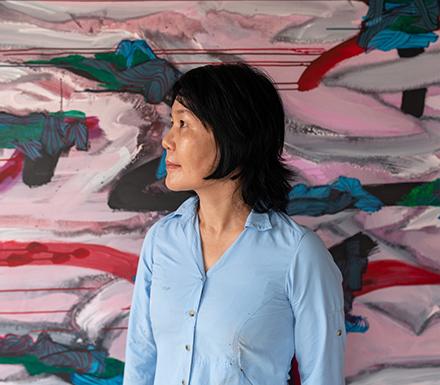
 Born in 1963 in Qingshui, Taichung, Taiwan, Suling Wang graduated with a BA in Fine Art from Central Saint Martins College of Art and Design, London, in 1997, and earned an MA in Painting from the Royal College of Art, London, in 1999, where she subsequently established her studio. Since 2018, she has divided her time between Taiwan and the United Kingdom for both living and artistic practice.
Born in 1963 in Qingshui, Taichung, Taiwan, Suling Wang graduated with a BA in Fine Art from Central Saint Martins College of Art and Design, London, in 1997, and earned an MA in Painting from the Royal College of Art, London, in 1999, where she subsequently established her studio. Since 2018, she has divided her time between Taiwan and the United Kingdom for both living and artistic practice.
As an artist who traveled from Taiwan to study in the UK, Wang has long navigated the tensions inherent in cross-cultural experience. Growing up along the Dajia River instilled in her a deep connection to Eastern cultural heritage and natural landscapes, while life abroad heightened her awareness of the challenges and solitude of being an Asian expatriate. The geographical and psychological distances between East and West have become a central driving force in her work. Through painting, she transforms internal conflict into balance, finding her own cultural and emotional grounding through flowing colors and gestural brushwork.
Wang is renowned for her large-scale abstract paintings. Her works feature fluid lines and layered brushstrokes that both echo traditional Eastern "cun" brush textures and embody memories of her homeland. Through layered paint and spatial composition, she creates an interstitial "complex space" between abstraction and representation, unifying fragmented perceptions and memories into a coherent temporal and spatial field. Unlike Western landscape painting, which often emphasizes visual representation, her landscapes convey a distinct Eastern perceptual and emotional sensibility.
In 2004, Wang was invited to participate in a group exhibition at Victoria Miro Gallery, London, presenting three monumental works—a pivotal moment in her career. The following year, she held her first solo exhibition at the same gallery. In 2006, her work Liwu River Loops (2005) was selected for the Passion for Paint exhibition at the National Gallery, London, making her one of the few contemporary artists featured in this landmark survey.
Her The Singing River series draws on her childhood along the Dajia River, reflecting a flowing connection between homeland and diasporic experience. In 2016, she was commissioned by the U.S. Department of State to create the nine-meter-long painting The Singing River 2 (2017-2018) for the American Institute in Taiwan (AIT), completed over three years and exhibited at AIT's new Taipei facility. This work cemented her international recognition and led to the establishment of a permanent studio in her Qingshui family home. In 2020, her painting The Singing River (2009-2011) was acquired by the Taipei Fine Arts Museum.
Since 2019, Wang has developed the Mountain Language series, inspired by a one-act play of the same name she saw in London in 2001. For Wang, "mountains" symbolize her childhood environment and serve as metaphors for her parents. Recurring motifs such as butterflies reference her father's forestry work and the landscapes of Maolin, while dense "dots" on the canvas evoke her emotional bond with her late mother, crystallized like tears into a unique visual vocabulary. These series convey not only landscapes but also familial ties, nostalgia, and traces of lived experience.
In 2019, Suling Wang received the Hirshhorn Museum and Sculpture Garden's highest annual honor in Washington, D.C., becoming the first Taiwanese artist to be so recognized.
In 2023, she became the first Taiwanese artist to be awarded the U.S. Department of State's Medal of Arts, receiving the distinction at the White House from then–First Lady Dr. Jill Biden. Established in 2012 by the U.S. Department of State in partnership with the Art in Embassies program, the Medal of Arts honors artists who have made outstanding contributions to cultural diplomacy. For Wang, this award represents the highest international recognition of her artistic achievements.
Wang's work has been exhibited at major international institutions, including the National Gallery, London; the Museum of Fine Arts, Houston; and the National Gallery of Victoria, Melbourne. Her work is held in prominent collections such as the U.S. Department of State, Solomon R. Guggenheim Museum (New York), Museum of Contemporary Art (Los Angeles), Utah Museum of Fine Arts, Cincinnati Art Museum, UBS Art Collection (Switzerland), and the London Stock Exchange, reflecting her distinguished status in the global contemporary art arena.